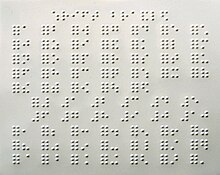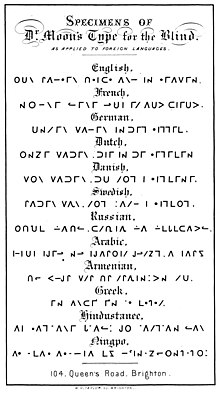lingvo.wikisort.org - Alphabet
Russian Braille is the braille alphabet of the Russian language. With suitable extensions, it is used for languages of neighboring countries that are written in Cyrillic in print, such as Ukrainian and Mongolian. It is based on the Latin transliteration of Cyrillic, with additional letters assigned idiosyncratically. In Russian, it is known as Шрифт Брайля (Shrift Braylya, 'Braille Script').
This article uses bare URLs, which are uninformative and vulnerable to link rot. (September 2022) |
| Russian Braille | |
|---|---|
 | |
| Script type | Alphabet
|
Print basis | Russian alphabet |
| Languages | Russian |
| Related scripts | |
Parent systems | Braille
|
Alphabet
The Russian Braille alphabet is as follows:[1][2][3]
| а a | б b | в v | г g | д d | е e, ye | ё yo | ж zh | з z | и i | й[4] y | |
|---|---|---|---|---|---|---|---|---|---|---|---|
| Braille | |||||||||||
| к k | л l | м m | н n | о o | п p | р r | с s | т t | у u | ф f | |
| Braille | |||||||||||
| х kh | ц ts | ч ch | ш sh | щ shch | ъ ” | ы y | ь ’ | э e | ю yu | я ya | |
| Braille |
The adaptation of ⠟ q to ч [tɕ] and ⠭ x to щ [ɕː] is reminiscent of the adaptation in Chinese pinyin of q to [tɕ] and x to [ɕ].
Contractions are not used.[1]
Obsolete letters

The pre-Revolutionary alphabet, reproduced at right from an old encyclopedia, includes several letters which have since been dropped. In addition, the letter э is shown with a slightly different form.[5]
| ѳ th | і i | ѣ ě | э è | |
|---|---|---|---|---|
| Braille |
Although obsolete in Russian Braille, these letters continue in several derivative alphabets.
Punctuation
Single punctuation:[3]
| , | .[6] | ? | ! | ; | : | - | — | |
|---|---|---|---|---|---|---|---|---|
| Braille |
Paired punctuation:[citation needed][The inner quotes and the brackets are from Unesco (1990) and have not been confirmed.]
| « ...... » (outer quote) |
„ ...... “ (inner quote) |
( ...... ) | [ ...... ] | |
| Braille |
Formatting
| italics | capital | number | column |
|---|---|---|---|
Columns marked with ⠿ are shown in the braille-chart image in the box, above right.
Numbers and arithmetic
Numbers are the letters a–j introduced with ⠼, as in other alphabets. Arithmetical symbols are as follows. The lowered g used for parentheses in prose becomes an equal sign in arithmetic, where a symmetrical pair of parentheses is used instead:[3]
| + | − | × | · | : | = | |
|---|---|---|---|---|---|---|
| Braille |
| < | > | ( | ) | √ | % | |
|---|---|---|---|---|---|---|
| Braille |
Arithmetical symbols are preceded but not followed by a space, with the exception of the multiplication dot. For example:
- ⠼⠋⠀⠦⠼⠛⠀⠲⠼⠁⠙⠀⠶⠼⠉
- 6 × 7 : 14 = 3
- ⠼⠉⠄⠣⠼⠊⠀⠤⠼⠛⠜⠀⠶⠼⠋
- 3 · (9 − 7) = 6
- ⠩⠱⠼⠁⠚⠚⠚⠚⠀⠪⠀⠼⠁⠚⠁
Extensions for other languages
In print, many languages of the ex–Soviet Union are written in Cyrillic alphabets derived from the Russian alphabet by adding new letters. Their braille alphabets are similarly derived from Russian Braille. The braille assignments for the letters found in Russian print are the same as in Russian Braille. However, there is no international consistency among the additional letters, apart from ⠽ і, which is used in Ukrainian, Belarusian, and Kazakh – and even then, Kyrgyz uses ⠽ for ң (ŋ), and it might be that Tajik uses it for қ (q). Generally not all of the Russian letters are used, except perhaps in Russian loans. Punctuation and formatting, as far as they are attested, agree with Russian Braille, though Kazakh Braille is reported to use the Russian arithmetical parentheses ⠣⠀⠜.
Ukrainian Braille
Ukrainian has the additional letters і, ї, є, ґ. The є is the mirror image of old Russian э, while і is the old Russian і (that is, it is the mirror image of й, making it the same as French/English y), and ї is old Russian ѣ.[7]
| є | ґ | і | ї | |
|---|---|---|---|---|
| Braille |
Unesco (2013) was unable to verify these values.[8]
Belarusian Braille
Belarusian has the additional letters і and ў. They are the mirror images of й and у.[unreliable source?]
| і | ў | |
|---|---|---|
| Braille |
Unesco (2013) was unable to verify these values.[8]
Kazakh Braille
Kazakh has the additional letters ә, ғ, қ, ң, һ, ө, ү, ұ, і.[8]
| ә | ғ | қ | ң | ө | ү | ұ | һ | і | |
|---|---|---|---|---|---|---|---|---|---|
| Braille |
See Kazakh alphabets#Correspondence chart for the whole braille alphabet aligned with the Cyrillic.
Kyrgyz Braille
Kyrgyz has a subset of the Kazakh letters, ң, ө, ү, but with completely different braille values from the languages above:[8][9]
| ң | ө | ү | |
|---|---|---|---|
| Braille |
See Kyrgyz alphabets#Correspondence chart for the whole braille alphabet aligned with the Cyrillic.
Mongolian Braille
Mongolian has ө, ү, but with different braille assignments again:[8]
| ө ö | ү ü | |
|---|---|---|
| Braille |
These are two of the obsolete Russian Braille letters. The Mongolian vowel ө (ö) is coincidentally similar in print to the old Russian consonant ѳ (th), and takes the latter's braille assignment; the Mongolian vowel ү (ü) takes the assignment of the old Russian vowel yat.
See Mongolian Cyrillic alphabet for the whole alphabet aligned with Cyrillic.
Tatar Braille
Additional alphabets
Unesco reported additional braille adaptations of Cyrillic in 1990, for Tajik, Turkmen and Uzbek, but was not able to confirm them by 2013.[8] The additional letters in the report are shown here, but like those of Ukrainian and Belarusian, they are unverified and should be treated with caution.
Tajik Braille
| ғ | ӣ | қ | ӯ | ҳ | ҷ | |
|---|---|---|---|---|---|---|
| Braille |
Turkmen Braille
| Cyrillic | ә | җ | ң | ө | ү |
|---|---|---|---|---|---|
| Latin | ä | j | ň | ö | ü |
| Braille |
Uzbek Braille
| Cyrillic | ғ | қ | ў | ҳ |
|---|---|---|---|---|
| Latin | gʻ | q | o' | h |
| Braille |
See also

- Moon type is a simplification of the Latin alphabet for embossing. An adaptation for Russian-reading blind people has been proposed.
References
- http://specposobie.narod.ru/brail/
- 萬明美, 2001, 「視障教育」, 五南圖書出版股份有限公司, p. 108
- РЕЛЬЕФНО-ТОЧЕЧНЫЙ ШРИФТ БРАЙЛЯ
- note this is the mirror image of Braille y
- It is possible this is just a copy error. However, the fact that Ukrainian є is the mirror image of this letter in both braille and print lends it credence.
- And thus ⠲⠲⠲ for ellipsis
- БРАЙЛЯ ШРИФТ, Leksika.com.ua
(ґ is not reported) - World Braille Usage, UNESCO, 2013
- UNESCO (2013) has a typographic error for ⠊ и.
Другой контент может иметь иную лицензию. Перед использованием материалов сайта WikiSort.org внимательно изучите правила лицензирования конкретных элементов наполнения сайта.
WikiSort.org - проект по пересортировке и дополнению контента Википедии
